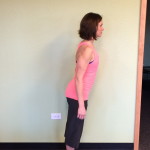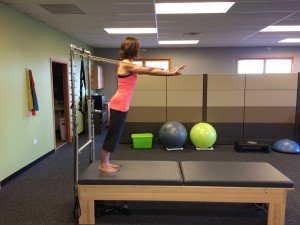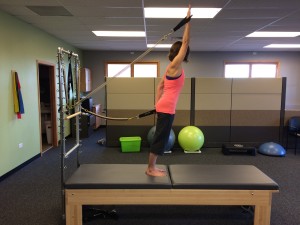Pilates for Triathletes Run Part II: “Lean Into the Wind”
Running. You either love it or you hate it. But, because it is a convenient form of exercise, a lot of people choose to run…with or without the love. And, most runners don’t usually think about their trunk position while running; they just get up and run. However, the position of the spine in space has significant impact on musculoskeletal tissue throughout the body. If you lean too far back, the structures in front of the body (ie. knees) are susceptible to increased forces. If you run with a slouched posture, back pain is a likely result. What would happen to your run if you simply leaned into the wind?
What does “Lean Into the Wind” mean?
Once again, Pilates has mastered the ability to teach the correct trunk position for optimal core activation and breathing. “Lean into the wind” is a common cue in Pilates to allow proximal trunk stability for distal extremity mobility. This position is a slight forward lean of a long spine that instantly turns on the core. It’s very active and sets the diaphragm up for optimal breathing. (Remember, the diaphragm is a core muscle). As a singer (ahem, yes in my younger years), I learned this lean in order to breathe better. Well, don’t we want to breathe better while running too? Of course! But, that’s not all this position does for runners.
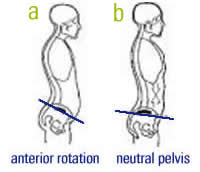 Having a long and strong trunk position is important for many reasons. We breathe better, the core is activated and the spine is working in its healthiest state. While running, the lumbar spine (low back) is mainly responsible for lateral flexion (side-bending) of the spine. The thoracic spine (mid-back) contributes to rotating the spine, allowing our arms to pump reciprocally for balance. In addition, the lumbar spine and pelvis act to oppose thoracic spine flexion (rounded mid-back). Why is this important? If the spine is erect, then a neutral pelvic position (figure b) is easy to achieve and maintain. However, if the thoracic spine is flexed (figure a), the lumbar spine and pelvis are forced to counter that flexion. This results in an increased anterior tilt of the pelvis and lumbar lordosis. And, that combo screams back pain.
Having a long and strong trunk position is important for many reasons. We breathe better, the core is activated and the spine is working in its healthiest state. While running, the lumbar spine (low back) is mainly responsible for lateral flexion (side-bending) of the spine. The thoracic spine (mid-back) contributes to rotating the spine, allowing our arms to pump reciprocally for balance. In addition, the lumbar spine and pelvis act to oppose thoracic spine flexion (rounded mid-back). Why is this important? If the spine is erect, then a neutral pelvic position (figure b) is easy to achieve and maintain. However, if the thoracic spine is flexed (figure a), the lumbar spine and pelvis are forced to counter that flexion. This results in an increased anterior tilt of the pelvis and lumbar lordosis. And, that combo screams back pain.
 Now I don’t know who this guy is, but found it on the web. Perfect lean. (And, he’s kinda nice to look at too).
Now I don’t know who this guy is, but found it on the web. Perfect lean. (And, he’s kinda nice to look at too).
Blog Activity: Find Your Lean
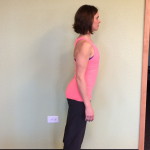 Stand with your feet under your hips. Stack your shoulders over your hips to find a tall posture. Activate your core by pulling the belly toward your spine. Lift your ribs away from your hips without lifting your shoulders. Lean slightly forward (heels stay on floor) until you feel a position of increased core activation. That’s it. The lean is not countering gale force winds, it’s subtle. And it gives the diaphragm, core, spine, lower extremity and upper extremity muscles the best opportunity to do their job!
Stand with your feet under your hips. Stack your shoulders over your hips to find a tall posture. Activate your core by pulling the belly toward your spine. Lift your ribs away from your hips without lifting your shoulders. Lean slightly forward (heels stay on floor) until you feel a position of increased core activation. That’s it. The lean is not countering gale force winds, it’s subtle. And it gives the diaphragm, core, spine, lower extremity and upper extremity muscles the best opportunity to do their job!
Another reason to find “The Lean”: Prevents Injury
Here is a list of the most common running injuries, most prevalent to least prevalent.
- PFPS (Patellofemoral Pain Syndrome)…fancy word for knee pain
- IT Band Syndrome
- Plantar Fasciitis
- Meniscus injuries
- MTSS (Medial Tibial Stress Syndrome)…fancy word for shin splints
- Patellar tendinitis
- Achilles tendinitis
And, what is the most commonly injured area of a runner? The knee. This hinge joint is responsible for ~42% of all running pain. That is almost half of all injuries. Wouldn’t it be great if you could decrease the stress at the knee without changing our preferred foot strike pattern or buying 1,000 different shoes? You can…just lean 7 degrees more.
Teng H, et al published a cool research study in 2014. A 6.8º (we’ll just say 7º) increase in trunk flexion (lean from the hips) decreased the force at the knee by 6%. This may not seem like a lot, but if you put a lot of miles on your feet, 6% is meaningful over time. But, here’s the other piece. A 3.3° decrease in lean, increased the force at the knee by 7.4%. Yikes! If you’re not sold on the lean forward to decrease the load on the knee, just think about that less of a lean will increase the load!
This is what an increase of ~7º of trunk flexion looks like from the lean into the wind position. It’s not that much. And, if you have knee pain, you may want to try this combo. However, if you are not leaning at all, just try that first. It may just take away that knee pain.
Hope you try to lean into the wind on your next run.
Take home points
- Lean into the wind is a strong and stable trunk position for optimal running
- If you have difficulty breathing, back pain or knee pain with running, your trunk position may be the culprit
- Pilates is an excellent cross-training choice to teach an erect spine position
Here a few Tower exercises I use to teach good trunk position and the concept of “Lean Into the Wind”.
Standing Push-Up
Butterfly
Kneeling Arm Circles
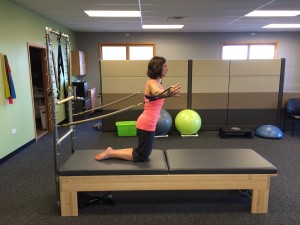
© 2015 and Beyond. ALL BLOG CONTENT at duncansportspt.com by Lori Duncan PT
 ABOUT THE AUTHOR
ABOUT THE AUTHOR
Lori Duncan, DPT, MTC, CPT is a respected Physical Therapist, Manual Therapist and Pilates instructor in Lafayette, CO. Lori is passionate about preventive physical therapy and education and is a nationally recognized presenter. She can be reached at [email protected]. You can also follow Duncan Sports Therapy + Wellness on Facebook & Instagram for more free tips and information.
References
Teng H, Powers C. Sagittal plane trunk posture influences patellofemoral joint stress during running. Journal Ortho Sports Phys Ther. 2014;44(10):724-840.
Shinkle J, Nesser TW, Demchak TJ, McMannus DM. Effect of core strength on the measure of power in the extremities. J Strength Cond Res. 2012;26(2):373-80.
MacWilliams, BA, Rozumalski A, Swanson AN, et al. Three-dimensional lumbar spine vertebral motion during running using indwelling bone pins. Spine. 2014;39(26):1560-5.


